Qammer H. Abbasi, Martin Weides, Chong Li, and Muhammad Ali Imran
Published: 23 Feb 2024

CTN Issue: February 2024
A note from the editor:
Buckle up for a journey into the future of secure data transmission! In this month's article Qammer H. Abbasi, Martin Weides, Chong Li, and Muhammad Ali Imran from University of Glasgow presents the promises of Quantum Communication and chart the course for what lies ahead.
Quantum Communication is not just science fiction—it's the real deal! By harnessing the quirky laws of quantum physics, we're now revolutionizing the way we send data securely across the globe. No more cat-and-mouse games with hackers; quantum properties like superposition and entanglement make our transmissions virtually hack-proof.
The article seamlessly weaves together theoretical concepts with practical implications, offering you a comprehensive roadmap to navigate the intricate terrain of quantum communication. From the elusive dance of qubits to the practicalities of quantum key distribution, the authors leave no stone unturned in their exploration of this cutting-edge field. But, challenges persist, and we're here to tackle them head-on, paving the way for a quantum-powered future! Enjoy this article and let us have your comment.
Muhammad Zeeshan Shakir, CTN Editor
Promise of Quantum Communication and What Is Next?

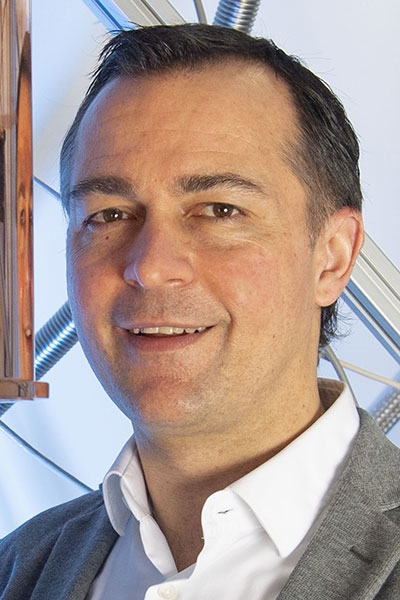
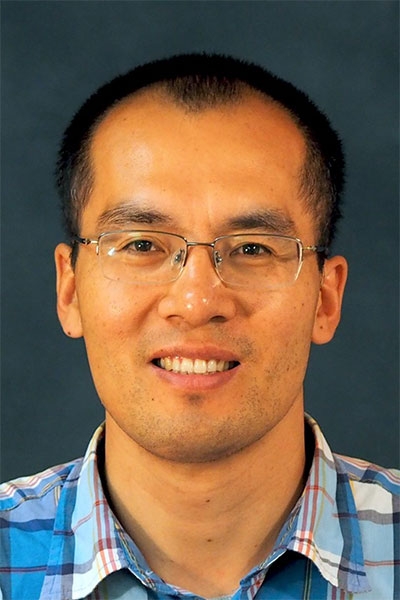

Abstract
Quantum Communication revolutionizes secure data transmission by leveraging quantum physics to address encryption vulnerabilities. Unlike the traditional methods based on classical electronic and optics, it utilizes quantum properties like superposition and entanglement, making manipulation attempts detectable for unmatched security. Challenges persist in establishing global quantum communication networks, requiring significant advancements in techniques like signal detection, storage and quantum repetition. Future trends emphasize enhancements in methodologies for improved efficiency, including detectors, to achieve transformative changes in secure protocols and network performance.
1. Quantum Communication: Enhancing Secure Data Transmission
In our interconnected world, data security is a top concern, especially in traditional communication methods where encryption faces growing challenges. Conventional encryption methods, reliant on mathematical algorithms, are increasingly vulnerable to sophisticated hacking attempts and the looming threat of quantum computing [1]. The integrity of transmitted data in conventional communication encounters encryption challenges due to rapidly advancing computational power, which surpasses traditional encryption's resilience [2]. Quantum computing poses an imminent risk, potentially decoding widely used encryption algorithms [3] and creating vulnerabilities [4]. Secure key distribution remains a persistent issue, prone to interception or impersonation [5]. Data integrity and authentication during transmission are also problematic, particularly in IoT devices and cloud-based systems, leaving openings for data tampering [6]. Despite efforts to strengthen encryption, evolving cyber threats persistently exploit communication system vulnerabilities, necessitating exploration of more resilient alternatives like quantum communication to safeguard data against emerging risks and technological advancements.
2. Quantum Communication as an Effective Solution
Quantum communication emerges as a groundbreaking and potent solution poised to revolutionize secure data transmission amidst the vulnerabilities plaguing conventional encryption methods. Rooted in the principles of quantum mechanics, quantum communication harnesses the unique properties of quantum particles, specifically quantum bits (qubits), to establish highly secure and virtually tamper-proof communication channels [7]. At its core, quantum communication utilizes quantum entanglement and superposition, phenomena wherein qubits can exist in multiple states simultaneously and share an inseparable connection across distances, offering a new paradigm for secure data transfer [8]. Unlike traditional encryption methods vulnerable to increasing computational power and the impending threat of quantum computing, quantum communication ensures unconditional security by leveraging the no-cloning theorem, preventing any direct duplication of quantum information and hence eavesdrop introducing detectable anomalies [9]. This forms the bedrock of secure data transmission in quantum communication, ensuring data integrity and authenticity while detecting any attempts at interception. Moreover, quantum communication not only promises high-level security but also demonstrates potential for increased information capacity, allowing more efficient and rapid data transmission [10]. As conventional encryption methods face escalating challenges, quantum communication stands out as a robust and forward-thinking solution, providing resilience against emerging threats and positioning itself as the cornerstone of next-generation secure communication networks.
3. Quantum Mechanics: Pioneering the Future of Ultra-Secure Data Transmission
Quantum communication is based on several fundamental principles of quantum physics, including superposition, entanglement, and the no-cloning theorem as mentioned earlier and shown in Figure It leverages several foundational principles to ensure secure transmission of information. Firstly, utilizing quantum bits (qubits) based on superposition enables encoding information in multiple states simultaneously, exponentially expanding data capacity compared to classical bits [8].
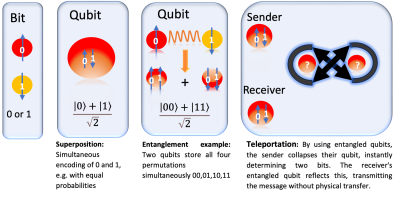
Secondly, entanglement links qubits regardless of distance, ensuring one state inextricably linked to the other, forming a highly secure (and instant) transmission method. The no-cloning theorem prohibits exact replication of quantum states, guaranteeing unconditional security; any unauthorized attempt at copying or intercepting the state alters it irreversibly, signalling potential tampering [9]. Quantum measurement collapses a qubit's superposition irreversibly, preventing eavesdroppers from gaining complete information without detection. Teleportation, in the context of quantum mechanics, involves the transfer of quantum information from one location to another without physically moving the particles themselves, relying on entanglement and a separate classical communication channel to recreate the quantum state of an object or particle at a distant location.
4. Quantum Cryptography
Quantum cryptography, at the nexus of quantum physics and cryptography, revolutionizes secure communication through the use of quantum particles, mainly photons, for quantum key distribution (QKD) (Fig. 2 a), establishing ultra-secure channels for unparalleled data security, combating cyber threats [6]. However, practical implementation faces hurdles such as maintaining quantum coherence across distances, lowering error rates, and enhancing hardware for efficient key distribution. While currently serving sectors like government communications and finance, its potential extends to secure voting, healthcare privacy, and fortified cloud computing. Ongoing research aims to overcome these obstacles, concentrating on expanding networks, employing quantum repeaters, and developing post-quantum encryption. Advancements and continued research are crucial for practical application beyond research labs.
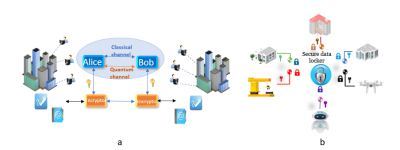
Quantum communication protocols leverage quantum principles to establish unbreakable security in networks, countering vulnerabilities of conventional encryption and the rise of quantum computing threats. In Quantum Key Distribution (QKD), quantum bits enable the creation of a secret key between parties via superposition and entanglement. These keys form the basis for subsequent encrypted communication using secret key cryptography as shown in Fig 2b [11]. Through this process, data is encrypted using the shared key generated via QKD, ensuring secure transmission and safeguarding information from potential adversaries [12]. For practical reasons, experimentally the QKD states are almost always shared via free path optics or are fibre-based.
5. Quantum Communication Protocols
Quantum communication protocols, like the pioneering BB84, leverage quantum principles for secure cryptographic key exchange [13]. BB84 uses polarization encoding for secure transmission, resistant to eavesdropping. Continuous Variable Quantum Key Distribution (CV-QKD) protocols, utilizing light's quadrature amplitudes, resist specific channel noise and are suitable for long-distance transmission [14]. Diverse protocols like E91, SARG04, B92, and others [15–19] employ quantum entanglement, non-orthogonal states, or coherent light for secure key exchange, catering to various security needs, distances, and implementation feasibility. Ongoing research aims to enhance security and efficiency, adapting to diverse applications and technological limitations in quantum communication.
6: Quantum Interconnects
As depicted in Figure 3, Quantum information circuits (QIC) play an integral role in virtually all conceivable quantum information processing systems, encompassing quantum computing, quantum sensing, and quantum communication. Modular quantum computing schemes are the most viable avenues for achieving scalability to large numbers of error-corrected qubits. Given the pivotal reliance of modular approaches on efficient QIC, a substantial and targeted investment is essential in next phase of networked quantum computing. Quantum communication systems also rely on quantum interconnects to transfer entanglement between devices, crucial for noisy intermediate‐scale quantum computing [20]. The Quantum Switch (QS) is central to various quantum information systems, ensuring coherence and entanglement preservation. Implementing these interconnects faces technical challenges, demanding precise transmission of quantum states across energies with minimal loss and scalable capabilities. Accelerated research in materials and infrastructure will advance usable quantum technologies through quantum interconnects. Their deployment enables distributed quantum processing. Short-distance interconnects can exist on or between chips, while long-distance ones rely on photons. Effective transducers are necessary to connect to non-photonic qubits, e.g. at microstate frequencies. The interconnected quantum computers form the quantum internet, facilitating global quantum correlation distribution and coordinated utilization [21].
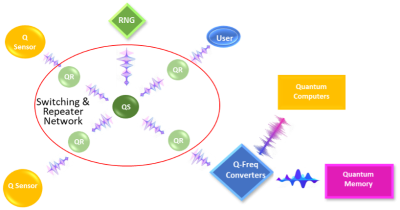
Figure 3: Quantum Information Circuits: The components include a Quantum Switch (QS), a Quantum Repeater (QR) designed to relay an entangled state from one set of qubits to a distant set without physically sending an entangled qubit the entire distance, a Quantum Frequency Converter (QFC), and a Random Number Generator (RNG).
Cutting-edge quantum communication advancements, including entanglement swapping, relays, and quantum repeaters, are reshaping secure and efficient long-distance data transmission. Entanglement swapping establishes quantum entanglement between distant particles, forming the basis for quantum relays that extend communication ranges. Quantum repeaters, futuristic solutions regenerating weakened quantum signals [22], promise to revolutionize quantum communication, becoming crucial for future quantum networks. Quantum memories, vital for storing and retrieving quantum data, enhance the efficiency of repeaters and support advanced operations [23]. Their potential lies in preserving delicate quantum states, contributing to the development of robust quantum networks. As quantum memories advance, their applications are expected to extend beyond communication, influencing quantum computing, cryptography, and sensing, and driving transformative technological advancements.
7. Challenges and Future Developments
Quantum Communication encounters significant hurdles in establishing scalable networks, fortified encryption, and error-free channels, which are indispensable for secure information transfer. Overcoming these challenges necessitates technological leaps, including the development of entanglement swapping, reliable relays [24], and efficient repeaters [25]. Insights gleaned from the Illinois Express Quantum Network (IEQNET) underscore crucial strategies [26]. Future endeavours must integrate photonic advancements [27], leverage high-bandwidth fibres for security [28], design robust protocols [29], and prioritize decoherence-resistant communication [30]. By emphasizing these aspects, a resilient quantum infrastructure for secure transmissions across diverse networks can be constructed. Figure 4 shows the future directions both in near and long term for quantum communication.
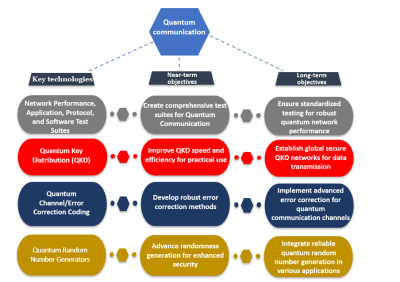
Quantum Key Distribution (QKD) grapples with challenges concerning key generation rates, long-distance use, and network integration [31-32]. Solutions necessitate technological advancements for achieving higher key rates and employing advanced repeaters. To facilitate global secure data transmission, scalable, standardized, and collaborative approaches are vital [19], as well as rigorous testing of networks, applications, and protocols [11].
Pivotal in reducing the decoherence, Quantum Error Correction (QEC) has witnessed advancements in circuits and learning techniques that enhance its effectiveness [33]. Encouraging experiments have demonstrated low error probabilities [34]. Improving hardware interface efficiency remains crucial, with strategies like a local "predecoder" enhancing decoding speed [35]. Continued exploration in error correction and novel decoding methods remains vital for future QEC development [36,37], aiming to counter decoherence, optimize computation, and address hardware errors for reliable communication. Quantum Random Number Generators (QRNG) aim to fortify security using reliable randomness and their integration across sectors ensures standardized security measures [38], crucial for securing sensitive data.
The future of Quantum Communication holds potential for further breakthroughs and applications. The integration of quantum communication protocols with emerging technologies such as artificial intelligence and machine learning could enhance the efficiency and adaptability of quantum systems [38]. This integration could lead to adaptive quantum networks capable of self-optimization, fault-tolerance, and dynamic reconfiguration, thus significantly advancing the reliability and scalability of quantum communication [39]. Furthermore, research into quantum teleportation and quantum teleportation-based communication protocols remains an exciting prospect [40]. If successful, this could potentially enable instantaneous and secure information transfer, transcending the limitations of conventional communication channels and paving the way for unparalleled data transmission capabilities [41,42]. Additionally, exploring the use of quantum communication in emerging fields, such as quantum Internet of Things (IoT) [43] and distributed ledger technologies (like blockchain) [44], offers avenues for innovative applications. Integrating quantum communication into these domains could usher in new paradigms of secure data processing, storage, and transmission, revolutionizing various industries and fostering new possibilities for secure, decentralized systems. In essence, the future of quantum communication involves continued research and development aimed at not only overcoming existing challenges but also exploring new frontiers of innovation, integration, and application across diverse technological landscapes to enable secure and efficient information exchange on a global scale.
8. Conclusion
The evolution of Quantum Communication signifies a ground-breaking leap in securing data transmission, utilizing quantum principles to address vulnerabilities inherent in conventional encryption methods. Quantum Key Distribution (QKD) exemplifies this progress, enabling secure key creation across vast distances for encrypted messaging, highlighting its potential for widespread adoption. However, challenges persist in establishing global quantum networks, necessitating advancements in error correction and network scalability. Despite these hurdles, ongoing innovations in Quantum Information Technology (QIT) promise transformative shifts in secure communication. Looking ahead, the resilience and adaptability of quantum-based systems offer a promising trajectory for Quantum Communication, not only in addressing current challenges but also in shaping a more secure and efficient global information exchange landscape.
References
- T. Niraula, A. Pokharel, A. Phuyal, P. Palikhel, and M. Pokharel, "Quantum computers’ threat on current cryptographic measures and possible solutions," Int. J. Wirel. Microw. Technol, vol. 12, pp. 10-20, 2022.
- S. Sharma, K. R. Ramkumar, A. Kaur, T. Hasija, S. Mittal, and B. Singh, "Post-quantum Cryptography: A Solution to the Challenges of Classical Encryption Algorithms," in Modern Electronics Devices and Communication Systems: Select Proceedings of MEDCOM 2021, pp. 23-38, 2023.
- J. K. Cheng, E. M. Lim, Y. Y. Krikorian, D. J. Sklar, and V. J. Kong, "A survey of encryption standard and potential impact due to quantum computing," in 2021 IEEE Aerospace Conference (50100), pp. 1-10, Mar. 2021.
- M. Prest and K. C. Chen, "Quantum-Error-Mitigated Detectable Byzantine Agreement with Dynamical Decoupling for Distributed Quantum Computing," arXiv preprint arXiv:2311.03097, 2023.
- F. Xu, X. Ma, Q. Zhang, H. K. Lo, and J. W. Pan, "Secure quantum key distribution with realistic devices," Rev. Mod. Phys., vol. 92, no. 2, p. 025002, 2020.
- V. Rao and K. V. Prema, "A review on lightweight cryptography for Internet-of-Things based applications," J. Ambient Intell. Humaniz. Comput., vol. 12, pp. 8835-8857, 2021.
- T. K. Paraiso et al., "A photonic integrated quantum secure communication system," Nature Photonics, vol. 15, no. 11, pp. 850-856, 2021.
- G. Rubino et al., "Experimental quantum communication enhancement by superposing trajectories," Phys. Rev. Res., vol. 3, no. 1, p. 013093, 2021.
- I. B. Djordjevic, Quantum Communication, Quantum Networks, and Quantum Sensing. Academic Press, 2022.
- M. B. Hastings, "Superadditivity of communication capacity using entangled inputs," Nat. Phys., vol. 5, no. 4, pp. 255-257, 2009.
- Y. Cao et al., "The evolution of quantum key distribution networks: On the road to the qinternet," IEEE Commun. Surveys Tuts., vol. 24, no. 2, pp. 839-894, 2022.
- F. Grünenfelder et al., "Fast single-photon detectors and real-time key distillation enable high secret-key-rate quantum key distribution systems," Nature Photonics, vol. 17, no. 5, pp. 422-426, 2023.
- M. Pereira et al., "Modified BB84 quantum key distribution protocol robust to source imperfections," Phys. Rev. Res., vol. 5, no. 2, p. 023065, 2023.
- G. Zhang et al., "An integrated silicon photonic chip platform for continuous-variable quantum key distribution," Nature Photonics, vol. 13, no. 12, pp. 839-842, 2019.
- W. Wang, F. Xu, and H. K. Lo, "Asymmetric protocols for scalable high-rate measurement-device-independent quantum key distribution networks," Phys. Rev. X, vol. 9, no. 4, p. 041012, 2019.
- R. Wang et al., "Optimized protocol for twin-field quantum key distribution," Commun. Phys., vol. 3, no. 1, p. 149, 2020.
- Y. Hatakeyama et al., "Differential-phase-shift quantum-key-distribution protocol with a small number of random delays," Phys. Rev. A, vol. 95, no. 4, p. 042301, 2017.
- H. L. Yin et al., "Measurement-device-independent quantum key distribution over a 404 km optical fiber," Phys. Rev. Lett., vol. 117, no. 19, p. 190501, 2016.
- M. Lucamarini et al., "Overcoming the rate–distance limit of quantum key distribution without quantum repeaters," Nature, vol. 557, no. 7705, pp. 400-403, 2018.
- H. J. Kimble, "The quantum internet," Nature, vol. 453, no. 7198, pp. 1023–1030, 2008.
- Q. Ruihong and M. Ying, "Research progress of quantum repeaters," in J. Phys.: Conf. Ser., vol. 1237, no. 5, p. 052032, Jun. 2019.
- W. Dai, T. Peng, and M. Z. Win, "Optimal remote entanglement distribution," IEEE J. Sel. Areas Commun., vol. 38, no. 3, pp. 540-556, 2020.
- D. Lago-Rivera et al., "Telecom-heralded entanglement between multimode solid-state quantum memories," Nature, vol. 594, no. 7861, pp. 37-40, 2021
- P. Zhang et al., "Future quantum communications and networking: A review and vision," IEEE Wireless Communications, 2022.
- S. Duranti, "Towards efficient quantum repeater nodes based on solid-state quantum memories," 2023.
- J. Chung et al., "Design and implementation of the Illinois Express quantum metropolitan area network," IEEE Transactions on Quantum Engineering, vol. 3, pp. 1-20, 2022.
- Z.-D. Li et al., "Testing real quantum theory in an optical quantum network," Physical Review Letters, vol. 128, no. 4, p. 040402, 2022.
- J. F. Dynes et al., "Cambridge quantum network," npj Quantum Information, vol. 5, no. 1, p. 101, 2019.
- M. Pompili et al., "Experimental demonstration of entanglement delivery using a quantum network stack," npj Quantum Information, vol. 8, no. 1, p. 121, 2022.
- W. Kozlowski, A. Dahlberg, and S. Wehner, "Designing a quantum network protocol," in Proceedings of the 16th international conference on emerging networking experiments and technologies, 2020, pp. 1-16.
- Y. Zhang et al., "Long-distance continuous-variable quantum key distribution over 202.81 km of fiber," Physical Review Letters, vol. 125, no. 1, p. 010502, 2020.
- C.-W. Tsai et al., "Quantum key distribution networks: challenges and future research issues in security," Applied Sciences, vol. 11, no. 9, p. 3767, 2021.
- V. V. Sivak et al., "Real-time quantum error correction beyond break-even," Nature, vol. 616, no. 7955, pp. 50-55, 2023.
- S. Krinner et al., "Realizing repeated quantum error correction in a distance-three surface code," Nature, vol. 605, no. 7911, pp. 669-674, 2022.
- S. C. Smith, B. J. Brown, and S. D. Bartlett, "Local predecoder to reduce the bandwidth and latency of quantum error correction," Physical Review Applied, vol. 19, no. 3, p. 034050, 2023.
- H. Wang et al., "Multidimensional Bose quantum error correction based on neural network decoder," npj Quantum Information, vol. 8, no. 1, p. 134, 2022.
- H. Wang et al., "DGR: Tackling Drifted and Correlated Noise in Quantum Error Correction via Decoding Graph Re-weighting," arXiv preprint arXiv:2311.16214, 2023.
- M. Herrero-Collantes and J. C. Garcia-Escartin, "Quantum random number generators," Reviews of Modern Physics, vol. 89, no. 1, p. 015004, 2017.
- J. Wallnöfer et al., "Machine learning for long-distance quantum communication," PRX Quantum, vol. 1, no. 1, p. 010301, 2020.
- M. Krenn et al., "Artificial intelligence and machine learning for quantum technologies," Phys. Rev. A, vol. 107, no. 1, p. 010101, 2023.
- B. Narottama and S. Y. Shin, "Federated Quantum Neural Network with Quantum Teleportation for Resource Optimization in Future Wireless Communication," IEEE Trans. Veh. Technol., 2023.
- Y. Wang et al., "Robust quantum teleportation via a non-Markovian channel," Phys. Rev. A, vol. 108, no. 6, p. 062406, 2023.
- N. Fiaschi et al., "Optomechanical quantum teleportation," Nat. Photonics, vol. 15, no. 11, pp. 817-821, 2021.
- T. M. Fernández-Caramés, "From pre-quantum to post-quantum IoT security: A survey on quantum-resistant cryptosystems for the Internet of Things," IEEE Internet of Things J., vol. 7, no. 7, pp. 6457-6480, 2019.
- H. Yi, "Secure social internet of things based on post-quantum blockchain," IEEE Trans. Network Sci. Eng., vol. 9, no. 3, pp. 950-957, 2021.
Statements and opinions given in a work published by the IEEE or the IEEE Communications Society are the expressions of the author(s). Responsibility for the content of published articles rests upon the authors(s), not IEEE nor the IEEE Communications Society.


